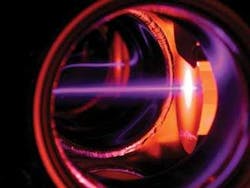LASER COOLING: Optical cooling, trapping extends to erbium
Physicists at the National Institute of Standards and Technology (NIST; Gaithersburg, MD) are using 401 nm laser light (see figure) to slow erbium atoms emerging from an oven at 1300°C, in preparation for trapping and cooling in an erbium magneto-optical trap (MOT).1 The NIST team heated erbium to more than 1300°C to make a stream of atoms. Magnetic fields and six counterpropagating laser beams were then used to cool and trap over a million atoms in a space about 100 µm in diameter. The laser beams were produced by a frequency-doubled single-frequency stabilized Ti:sapphire laser operating at 802 nm. The output of the doubler was directed into a series of acousto-optic modulators used as splitters and switches to produce the counterpropagating beams.
Until now, laser cooling and trapping has been possible only with atoms with closed, or nearly closed, optical-pumping cycles, such as alkalis, alkaline earths, and metastable rare gases. These materials have optical transitions that can be excited repeatedly without significant loss of population to energy levels that do not interact with the laser. For materials in which such population loss does occur, one or more auxiliary lasers would be needed to enable laser cooling and trapping by recycling the lost atoms. Consequently, major portions of the periodic table, including rare-earth elements such as erbium, which has 110 population-draining energy levels between the two used in laser cooling, have been considered off-limits to magneto-optical trapping.
The NIST researchers have shown, however, that the atoms lost in attempting to trap such materials can be recycled magnetically, which makes optical cooling and trapping feasible without the need for auxiliary lasers. The researchers found that as the erbium atoms spend time in the trap they fall into one or more of the 110 energy levels, stop responding to the lasers, and begin to diffuse out of the trap. Recycling occurs, however, because the atoms are sufficiently magnetic to be held in the vicinity by the trap’s magnetic field. Eventually, many of the lurking atoms fall back to the lowest erbium energy level, which resonates with the 401 nm laser light, enabling recapture of these atoms within the trap. Cooled and trapped erbium might prove useful for quantum computing and telecommunications. Trapped erbium atoms might also be used for doping semiconductor materials.
REFERENCE
1. J.J. McClelland and J.L. Hanssen, Physical Rev. Lett. 96, 143005 (April 14, 2006).
About the Author
Hassaun A. Jones-Bey
Senior Editor and Freelance Writer
Hassaun A. Jones-Bey was a senior editor and then freelance writer for Laser Focus World.
